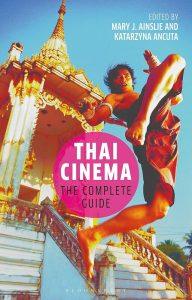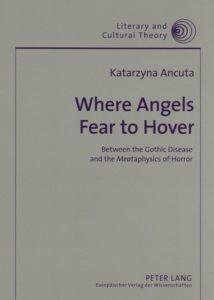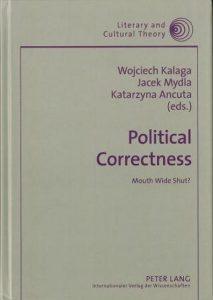South Asian Gothic: Haunted Cultures, Histories and Media
ed. Katarzyna Ancuta and Deimantas Valanciunas, Wales University Press, 2021
 This book is the first attempt to theorise South Asian Gothic production as a common cultural landscape, taking into account both the historical perspective and the variety of media texts. The volume consists of fifteen chapters by experts in film, literature and cultural studies of South Asia, representing the diversity of the region and a number of ways in which Gothic manifests in contemporary South Asian cultures. Gothic in South Asia can be read as a distinctive aesthetic, narrative practice, or a process of signification, where conventional Gothic tropes and imagery are assessed anew and global forms are consumed, appropriated, translated, transformed or resisted. The volume investigates South Asian Gothic as a local variety of international Gothic and part of the transnational category of globalgothic, contributing to the ongoing discussion on the need to de-westernise Gothic methodologies and ensure that Gothic scholarship remains relevant in the culturally-diverse modern world.
This book is the first attempt to theorise South Asian Gothic production as a common cultural landscape, taking into account both the historical perspective and the variety of media texts. The volume consists of fifteen chapters by experts in film, literature and cultural studies of South Asia, representing the diversity of the region and a number of ways in which Gothic manifests in contemporary South Asian cultures. Gothic in South Asia can be read as a distinctive aesthetic, narrative practice, or a process of signification, where conventional Gothic tropes and imagery are assessed anew and global forms are consumed, appropriated, translated, transformed or resisted. The volume investigates South Asian Gothic as a local variety of international Gothic and part of the transnational category of globalgothic, contributing to the ongoing discussion on the need to de-westernise Gothic methodologies and ensure that Gothic scholarship remains relevant in the culturally-diverse modern world.
Thai Cinema: The Complete Guide
ed. Katarzyna Ancuta and Mary J. Ainslie, I.B. Tauris/Bloomsbury, 2018
 One of the fastest growing and most internationally renowned cinemas in Southeast Asia is that of Thailand. In the first ever book devoted solely to this major centre of creative filmmaking, experts on contemporary and historic Thai film provide a timely overview and discussion of key films, directors and current movements in the region in a comprehensive encyclopaedia format. What many critics, analysts and scholars have retrospectively christened `New Thai Cinema’ began to take shape in the late 1990s when national film moved away from its position as lower-class and provincial entertainment and became a firm fixture in Bangkok multiplexes and festivals worldwide. This book will provide information on the influential figures behind the films – up to and succeeding the 1997 watershed film Dang Bireley’s and Young Gangsters that began the breakaway movement – as well as detailing and explaining the traditions of popular and art-house genres specific to Thailand. Featuring contributions on Thai visionaries such as Apichatpong Weerasethakul and Wisit Sasanatieng and providing rare insight into early Thai cinema, this is an essential scholarly guide to a vibrant aspect of Southeast Asian cinema – its history, industry and aesthetic trends – for scholars and students alike.
One of the fastest growing and most internationally renowned cinemas in Southeast Asia is that of Thailand. In the first ever book devoted solely to this major centre of creative filmmaking, experts on contemporary and historic Thai film provide a timely overview and discussion of key films, directors and current movements in the region in a comprehensive encyclopaedia format. What many critics, analysts and scholars have retrospectively christened `New Thai Cinema’ began to take shape in the late 1990s when national film moved away from its position as lower-class and provincial entertainment and became a firm fixture in Bangkok multiplexes and festivals worldwide. This book will provide information on the influential figures behind the films – up to and succeeding the 1997 watershed film Dang Bireley’s and Young Gangsters that began the breakaway movement – as well as detailing and explaining the traditions of popular and art-house genres specific to Thailand. Featuring contributions on Thai visionaries such as Apichatpong Weerasethakul and Wisit Sasanatieng and providing rare insight into early Thai cinema, this is an essential scholarly guide to a vibrant aspect of Southeast Asian cinema – its history, industry and aesthetic trends – for scholars and students alike.
Where Angels Fear to Hover: Between the Gothic Disease and the Meataphysics of Horror
Katarzyna Ancuta, Peter Lang, 2005
 Gothic and Horror have been perceived as intertwined ever since their coming into existence. Although initially emerging as clearly delineated literary genres, in the late 20th century we can speak of their transition into more open cultural categories. Gothic and Horror influences, previously limited to books and films, predominate in contemporary art, fashion, theatrical and performance art, video and multimedia installations, music, video and computer games. Gothic and Horror have invaded the language of politics and resulted in the formation of a number of subcultures styling their lives accordingly. The awareness of the above makes us realise that the insistence on the treatment of Gothic and Horror as separate genres is at least limiting, if not unacceptable. An alternative offered by this book, resulting from a thorough examination of the presence of Gothic and Horror conventions in contemporary culture, calls for an introduction of two new classificatory units, referred to in the book as Gothic and Horror syndromes, which can be brought down to the representations of disease and meat respectively.
Gothic and Horror have been perceived as intertwined ever since their coming into existence. Although initially emerging as clearly delineated literary genres, in the late 20th century we can speak of their transition into more open cultural categories. Gothic and Horror influences, previously limited to books and films, predominate in contemporary art, fashion, theatrical and performance art, video and multimedia installations, music, video and computer games. Gothic and Horror have invaded the language of politics and resulted in the formation of a number of subcultures styling their lives accordingly. The awareness of the above makes us realise that the insistence on the treatment of Gothic and Horror as separate genres is at least limiting, if not unacceptable. An alternative offered by this book, resulting from a thorough examination of the presence of Gothic and Horror conventions in contemporary culture, calls for an introduction of two new classificatory units, referred to in the book as Gothic and Horror syndromes, which can be brought down to the representations of disease and meat respectively.
Political Correctness: Mouth Wide Shut?
ed. Wojciech Kalaga, Katarzyna Ancuta and Jacek Mydla, Peter Lang, 2009
 The book addresses and interrogates discursive and cultural practices that are (or can be seen as) related to the well-established if elusive phenomenon known as Political Correctness or PC. The individual contributors look into PC-related cases within the humanities, literature, and the media. Accordingly, the publication is divided into three sections: Part I, “Revisiting the Issue: History, Theory, Language”, examines PC in the contexts of three types of discourse: historical, theoretical and ideological, and linguistic. Part II, “Literary Case Studies”, offers examinations of chosen literary works and authors. Part III, “The Media”, looks at manifestations of PC-related issues in film and the popular magazine. Altogether the publication shows a variety of approaches to the PC phenomenon. The assumption of the editors is that while PC has indubitably penetrated contemporary culture, it continues to stir controversy. This scholarly debate is a response to what may be described as PC’s universal reign.
The book addresses and interrogates discursive and cultural practices that are (or can be seen as) related to the well-established if elusive phenomenon known as Political Correctness or PC. The individual contributors look into PC-related cases within the humanities, literature, and the media. Accordingly, the publication is divided into three sections: Part I, “Revisiting the Issue: History, Theory, Language”, examines PC in the contexts of three types of discourse: historical, theoretical and ideological, and linguistic. Part II, “Literary Case Studies”, offers examinations of chosen literary works and authors. Part III, “The Media”, looks at manifestations of PC-related issues in film and the popular magazine. Altogether the publication shows a variety of approaches to the PC phenomenon. The assumption of the editors is that while PC has indubitably penetrated contemporary culture, it continues to stir controversy. This scholarly debate is a response to what may be described as PC’s universal reign.
